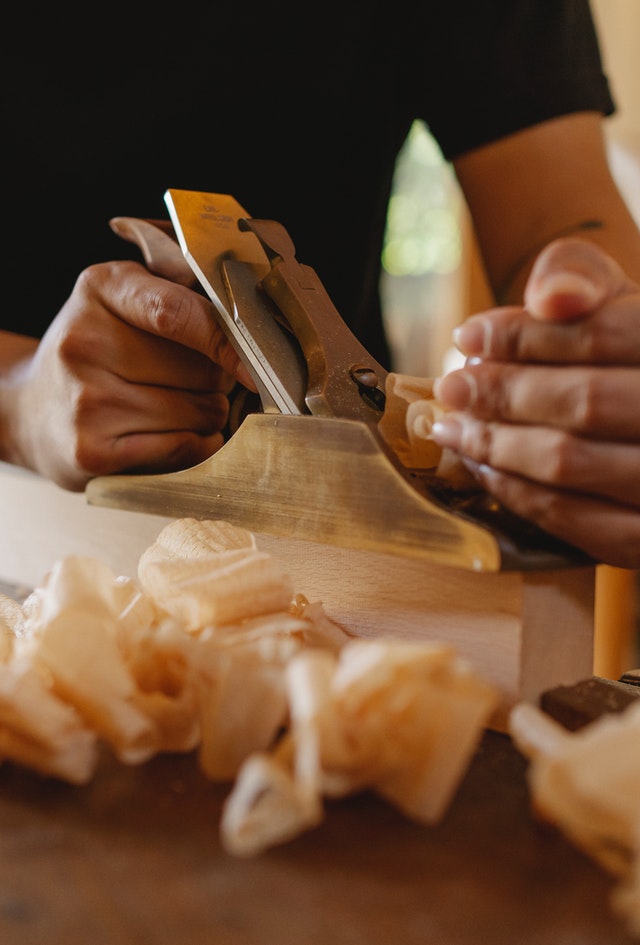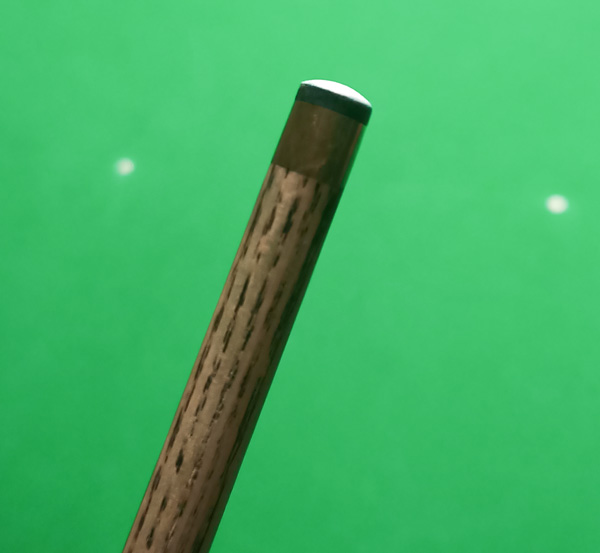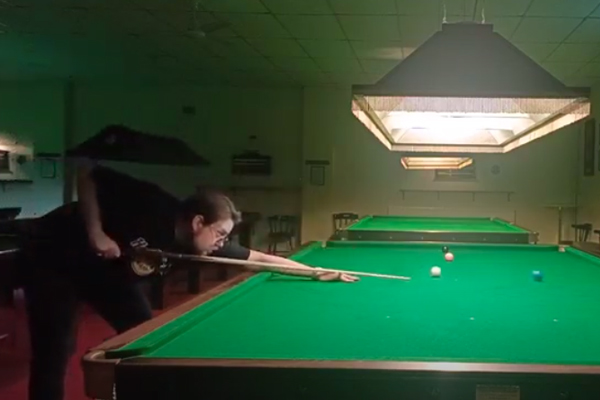In this article we’ll go over the materials used to make a snooker cue and why they’re used. You may be surprised at the answers!
Virtually every snooker cue is made almost entirely from wood. This is in contrast to American pool where many cues feature carbon fibre and other more modern materials.
However, there are other parts of the snooker cue which are not made from wood, for example the tip (more on this later). There are also often joints in the cue which are made from brass or steel, or even titanium recently.

Also, not all snooker cues are made from the same type of wood and most snooker cues feature several different types of wood.
The most commonly used wood for snooker cues is ash. In fact, the overwhelming majority of snooker cues are made from ash.
This wood is characterised by it’s relatively pale colour with quite a prominent and distinctive grain. If you think of a traditional snooker cue, you’re probably thinking of one that’s made from ash.

Maple is really the only commonly used replacement for ash. It has very little grain and tends to be paler in colour than ash. It also tends to produce a stiffer feel when striking the ball.
The choice between the two woods just comes down to personal preference. Both ash and maple can make excellent snooker cues but ash is overwhelmingly the most common choice for a snooker cue.
Ash (like maple) is a hardwood, which means, as the name suggests, that it is relatively hard when compared to other types of wood (such as softwoods). Hardwoods come from slower growing trees that produce a denser, and therefore harder wood.
Hardwood is stiffer and more durable than softwoods, which is why it is used for snooker cues. However, ash is special in that it is relatively soft and light when compared to other hardwoods such as oak. This means a lighter snooker cue can be produced which is sturdy but also provides some flexibility.
Having a lighter and more flexible cue allows the player to generate more speed and typically provides more “feel” to the player. Flexibility in a snooker cue also prodives some shock absorption, as well as reducing deflection.
Deflection is quite an advanced concept but it is basically where the cue ball gets “thrown” off line when playing with sidespin. A cue with very little flexibility will typically “throw” much more than a cue with some flexibility. Skilled players generally prefer a cue that deflects less as it tends to make sidespin shots easier to judge.
As an added benefit, because ash is not as dense as other hardwoods, it is also easier to shape into a snooker cue. This could be one of the main reasons that ash was initially selected for the purpose, combined with the fact that ash is quite readily available, especially in the UK where snooker was made popular.
Not many snooker cues are made entirely of one species of wood (such as ash). Usually, ash is used for the majority of the cue, from the tip (the part that strikes the ball) to almost all the way down the cue.
However, at the butt of the cue (the part the player holds), a heavier type of wood such as rosewood is often used. This is done to balance the cue, as well as for aesthetics.
Having more weight towards the butt of the cue is thought to provide the player with more control and power. A cue with more weight towards the butt tends to give a feeling of weight, without making the cue too heavy to accellerate through the shot. Additionally, more weight results in more force being applied to the ball on impact, producing a more powerful shot.
Rosewood is a particularly favoured wood for the butt of a cue as it is quite a denses wood. It’s dark colour also produces a pleasing aesthetic in the cue, offering a strong contrast between the pale ash.
Because rosewood is more expensive, it is less common on cheaper cues and tends to be used more sparingly on value options.
Ebony is used in snooker cues in much the same way that rosewood is. It provides weight to the butt of the cue, aiding in balance and weight.
In fact, ebony is one of the densest hardwoods available, meaning it is very effective at weighting a snooker cue, even more so than rosewood.
Ebony is also very dark, being even darker than rosewood. The weight of ebony, combined with it’s eye catching dark colour makes it one of the most saught after woods for snooker cues.
However, ebony is quite a rare wood. As such, snooker cues that utilise this wood tend to be expensive. In fact, many cheaper snooker cues imitate the look of ebony by using dyes. But of course, these cues cannot imitate the weight of ebony (although in some cases lead weights are used inside the butt for this purpose).
The best snooker cues are generally handmade from ash or maple wood with a butt containing ebony or rosewood.
It is not unusual for premium cues to feature both ebony and rosewood in the butt of the cue, generally with the heavier wood towards the bottom. As well as providing effective weighting, these woods in conjuction can produce a beautiful aesthetic, allowing cue makers to display their craftsmanship.
In fact, many of the most expensive cues use rarer woods for the butt, such as purpleheart wood. Although these exotic woods can provide effective weighting, they are generally selected for their aesthetic properties.
With regards to the main shaft of the cue, this is almost exclusively made from ash or maple, with ash being by far the most common. When ash is used in the best snooker cues, wood with the most prominent and consistant grain is generally selected. This is mostly for aesthetic reasons, though some players say the grain can help with alignment.
There isn’t anything in the rules of snooker that says a cue must be made of wood. Snooker cues can be made of various materials including fibreglass and aluminium. American pool cues are often made with these materials.
But in reality, virtually every snooker cue is made from wood. In fact, I can’t think of a single professional snooker player that doesn’t use a wooden cue.
It is worth mentioning that even cues made of fibreglass still feature a wooden core. The main advantage to the addition of fibreglass is durability. An all wooden cue couldn’t be kept in the boot (trunk) of a car for example, as the cue wood likely warp as it expands and contracts during temperature fluctuations. But a fibreglass cue would likely be fine in this type of environment.

That is why care of a wooden snooker cue is important. It should never be leant against a wall or stored in a warm place, or the boot of a car! But as long as a wooden cue is stored in a case or stored upright, it should last a very long time with little to no maintenance required.
Most snooker players use the same wooden cue for years. Many have used the same cue for decades! Although a wooden cue may not be as durable as a carbon fibre cue, when looked after and stored properly in a case, they can last a very long time.
The main reason that wood is used for snooker cues is generally accepted as being the “feel” that a wooden cue provides. This “feel” includes everything from the feel of the wood in the hands, the feel of the impact when striking a ball, and even the sound produced during contact.
Tradition is another big factor. Snooker cues have been made from wood as long as the game has existed. Making a handmade snooker cue is typically seen as an excellent display of craftsmanship. Although many cheaper, mass produced snooker cues are available these days, most professionals opt for a handmade cue.

One of the advantages to a handmade wooden snooker cue is that it can be tailored to the individual player. This includes custom weight, length, balance, type of wood, tip size, butt size, and even the overall profile of the cue. A handmade snooker cue can be made exactly how the player wants it.
Snooker cue tips are generally made of animal leather (laminated). There are some synthetic options available for those that seek them but for the most part, snooker tips are still made primarily from pig leather or water buffalo leather.
Leather provides excellent strength and durability, as well as being capable of producing lots of spin on the ball.

Spin is incredibly important in snooker, being central to positional play, at least at the highest level. Not only do different tips produce different amounts of spin, they can also produce varying amounts of deflection/throw (as mentioned previously) and they provide a different “feel”. That is why many snooker players consider the tip to be the most important part of the snooker cue.
The characteristics of the tip changes as it is used (bedded in). Each tip is slightly different as well (even the same brand) so retipping a cue is not garanteed to produce the same “feel” as the previous one. That is why most snooker players want their tips to last as long as possible.
On the subject of durability, this is the reason why there is a ferrule on a cue. This is the metal part which the tip is connected to (via glue). The ferrule is traditionally made of brass and its sole purpose is to protect the end of the cue from splitting. Before ferrules were introduces, a splitting snooker cue was commonplace, now it’s virtually unheard of.
As well as brass, ferrules can also be made of steel, and even titanium has been used in recent years. It is thought that less weight (mass) towards the tip can reduce deflection/throw when using sidespin. This is why some players are now chosing to use a titanium ferrule.
The snooker cue that a player uses can certainly make a difference. But there isn’t really anything in particular that makes a snooker cue “good”. You don’t have to spend a fortune on a snooker cue.
In fact, Stephen Hendry, considered by many to be the greatest snooker player ever, used the same snooker cue for virtually his entire career. It was a relatively cheap cue that he saved up to buy when he was 13 and he went on to win 7 world championships with it. He only changed cues when his old beloved cue broke in the baggage hold during a flight.
From a beginners perspective, the most important thing is to play with the same cue every time. This can massively help a player’s consistency. Playing with the same cue means that you get used to the way the cue performs, since no two cues are the same. It will probably also increase your enjoyment from playing snooker as you become more “attached” to your cue.

As long as the cue is straight, it should be “good” to play snooker with. The other characteristics of a snooker cue largely come down to personaly preference. The main characteristics include the length (usually 57-58 inches), the weight (usually 16-18 ounces), and the tip size (usually 9-10.5mm).
The length is typically determined by a player’s height, with taller players generally preferring a longer cue. The weight is mostly personal preference – it just comes down to what “feels” the best. In terms of tip size, this is also personal preference but a larger tip is generally recommended for beginners. Smaller tips can produce more spin but they are typically less forgiving.
Traiditional handmade snooker cues start life as a carefully selected long plank of ash or maple which is cut down to a square shape. It is then meticulously planed by hand until it becomes a round, tapered piece of wood that resembles a snooker cue.
Pieces of rosewood or maple are then added to the bottom of the cue for weighting and aesthetics, in a process known as splicing. Essentially, splicing involves planing the butt and glueing on the ebony or rosewood before planing back to a round shape.
At this point, the shape of the cue is set. The next steps are to sand and stain the cue, and to add a tip with a ferrule (usually made from brass). The sanding and staining helps to make the cue smooth and durable and the ferrule helps to protect the tip.
Often, cues will also feature a (typically brass) butt joint for an extension or they feature a joint in the middle of the cue so they can be halved for ease of transportation. Many professionals say they prefer the feel of a one piece cue (one without a joint) but of course, a two piece cue is much more practical for many people.
Any joints are done towards the end of the process and they are usually carried out on a lathe. The lathe rotates the wood rapidly, allowing the joints to be accurately drilled.
Handmade snooker cues don’t necessarily perform better than a machine made snooker cues. Many players prefer the look and feel of a handmade snooker cue but that doesn’t mean they instantly make you a better player.
Machine made cues are typically cheaper and they can still make perfectly “good” snooker cues. My first cue was a cheap machine made one which I stuck with for a very long time. I did notice the difference in the “feel” though when I switched to a handmade cue. But I can’t say that I noticed much difference in performance.
If possible, I would recommend buying a handmade snooker cue, you don’t have to spend a fortune to get a decent one. If you’re like me, you’ll enjoy the look and feel of a handmade cue and it’ll make you want to pick it up more often. But a cheap machine made cue would still be a step up from using a club cue. As I mentioned earlier, the most important thing is to use the same cue every time you play.
The flat part on the butt of a snooker cue is there to help the player to use the cue in the same orientation each time. As a player cues the shot, the cue often bends slightly across the chest in a vertical direction (up and down not side to side). By gripping the cue with the flat side, the player can ensure that this slight bend always stays in the same orientation and doesn’t affect the shot.

But this wasn’t the reason for the flat part originally, the answer may surprise you! In the early days of billiards, the flat part was in fact used for hitting the cue ball! Before tips were developed, billiard players used to hit the ball with a thick piece of wood on the end of a stick. This was known as a mace, rather than a cue.
When tips were invented (and the mace became a cue), the flat side on the butt was there so that players could play with either end of the cue. But why would you want to play with the butt? I hear you ask. Well, at the time there were no rests so if the shot was too far to reach, you would have to play it one handed with the butt! With the flat side to the table, you could slide the cue, somewhat effectively, across the table and into the shot.
This flat side has been retained in modern cues and now has a completely different purpose (for orientation). An additional benefit to the flat side is that it provides a convenient location for the makers badge.
To summarise, almost every snooker cue is made from wood with ash, maple, rosewood, and ebony being the primary woods used. The reason for wood is partly due to tradition and partly due to its effectiveness. It can be shaped relatively easily, it is very durable, it performs well, and it looks and feels great.
Personally, I couldn’t imagine using a cue that wasn’t made from wood. It feels so nice in the hand and also during the shot. It even has a pleasant sound to it. And to me, a handmade snooker cue is a thing of beauty, an incredible display of craftsmanship and a respectful nod to tradition.

If you are looking at buying a budget cue, I wouldn’t put you off buying a cheaper machine made cue because it’s still better to have your own cue and performance wise there isn’t a huge difference, especially for a beginner. But if you can, I would recommend a handmade cue, they probably aren’t as expensive as you think.

My name is Tom Rothwell and I’m a bit obsessed with cuesports! I’ve been playing pool and snooker since I was about 8 years old. I find American pool and English pool to be the most enjoyable with friends but I also enjoy the challenge of playing snooker.
As well as playing many different cuesports, I also enjoy watching the professionals. With this blog, I’m sharing as much of my knowledge as I can. Hopefully I can help some people out and maybe introduce some new players into the incredible games that are cuesports.